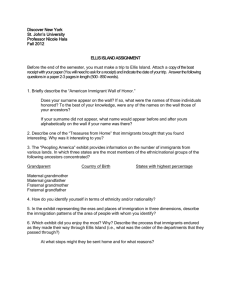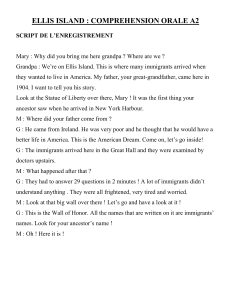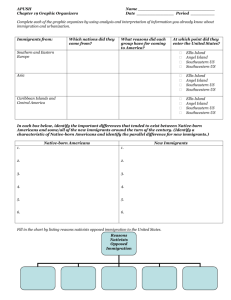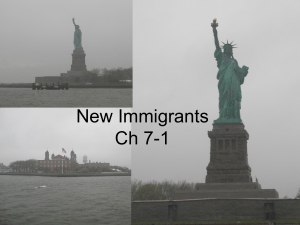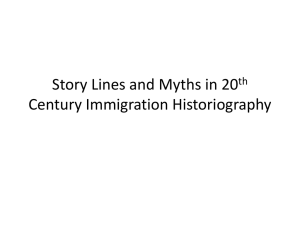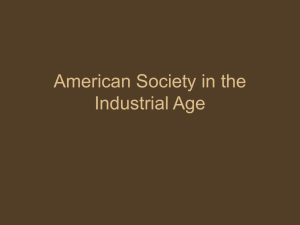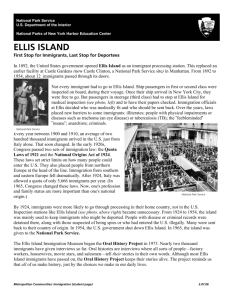Immigration-and-Citizenship
advertisement
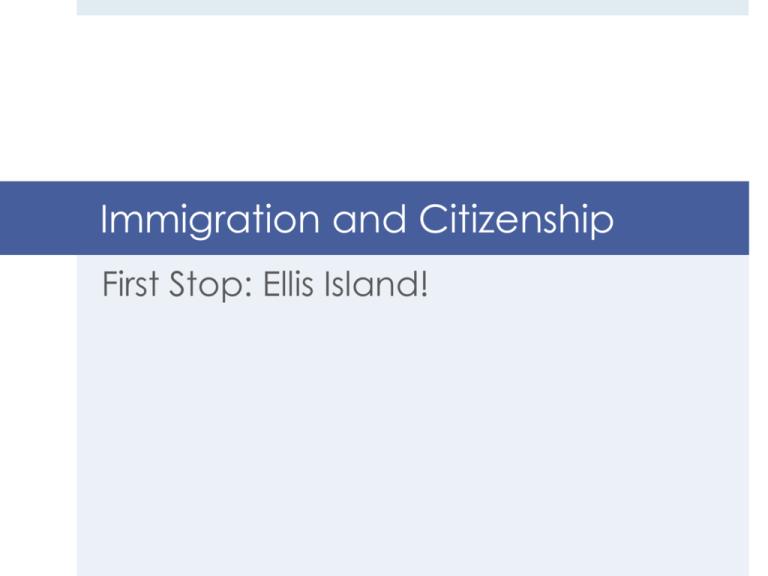
Immigration and Citizenship First Stop: Ellis Island! Objective Students will develop a sense of empathy with the experiences of immigrants who came to America. Students will recognize the importance of Ellis Island and the significance of the Statue of Liberty Vocabulary Words Immigrant – a person who leaves his or her own country to live in a different country port - a place where people and merchandise can enter or leave a country steerage - the lower part of a ship detainees - persons who are kept back from going on What is an immigrant? What does “e pluribus unum” mean? Why did the immigrants call the U.S. the “Land of Opportunity? Why was the Statue of Liberty so important to immigrants coming to America? Ellis Island The Golden Door- Simulation Today you will get the chance to see what it was like to be an immigrant arriving at Ellis Island. This kind of “acting out” is called a simulation and this experience will help you understand how the immigrants felt. Stop 1: Arrival New arrivals were taken by ferry to the main building at Ellis Island. Opened in 1892, the first immigrant to arrive was a 15-year-old girl from Ireland named Annie Moore to join her parents in New York City. Not everyone arriving in New York had to go to Ellis Island. Immigrants in first- and second-class were checked aboard their ships soon after docking on the mainland. After 1907, children under 16 had to be accompanied by their parents or else they would be sent back. Photo: National Park Service/US Dept. of Interior Stop 2: Baggage Claim Immigrants entered the main building through its ground floor baggage room. They left their trunks, suitcases and baskets here until they were finished. Immigrants with only a few belongings carried their things as they climbed the stairs to the Great Hall for medical and legal examinations. Children were a common sight at Ellis Island. During its 62 years in operation, 355 babies were actually born on the island! Photo: Bettmann/CORBIS Stop 3:Stairway to the Great Hall The first test the immigrants had to pass became known as the "six second medical exam." As the immigrants climbed the stairs to the Great Hall, doctors stood at the top and watched. They were looking for anyone having difficulty coming up the steps. Why would doctors be looking the people coming up the stairs? If a medical problem or was suspected, one of seventeen different chalk marks was put on the person's clothing. They were then sent for a full physical examination. If they weren't marked, they went on to wait in the Great Hall. Medical Chart X – Suspected Mental Defect G- Goiter Circled X- Definite Signs of Mental Defects H- Heart B – Back C- Conjunctivitis CT – Trachoma E- Eyes F- Face Ft- Feet K- Hernia N- Neck L- Lameness P- Physical & Lungs PG- Pregnancy SC- Scalp S- Senility SI- Special Inquiry Stop 4: Medical Exam By 1917, complete medical exams were required for every immigrant. The main purpose of these exams was to find persons with contagious diseases or that would make them unable to work. If their problem was curable, immigrants were sent to the island's hospital. If it was not, they would be sent back. Photo: Library of Congress Stop 5: The Great Hall The Great Hall was the large waiting room of Ellis Island. Immigrants waited here for their interviews with legal inspectors after finishing their medical exams. At best, the entire process through Ellis Island took three to five hours. But sometimes problems came up, like family members waiting for a relative to be treated in the hospital ward. Some families stayed for days on Ellis Island, others for weeks, and still others for months. Photo: Library of Congress Stop 6: Legal Inspection After passing the medical exams, immigrants had to prove they could legally come into America. They had to prove their country of origin and where they expected to live and work once they entered the country. Inspectors rejected any immigrant with a criminal record or those suspected of being indentured servants. By 1921, immigrants had to pass a literacy test and show a passport and visa. Photo: Library of Congress Stop 7: Money Exchange In the money exchange area immigrants exchanged the money of their homeland for dollars, and purchased any train tickets they needed. Laws passed in 1909 required each immigrant to have at least 20 dollars before they were allowed to enter America. Photo: National Park Service/US Dept. of Interior Stop 8: The Journey’s End Just beyond the money exchange was the exit from Ellis Island. Two thirds of the new Americans then boarded a ferry to New Jersey, where the next leg of their American journey would begin. The remaining third took the ferryboat to Manhattan to begin their new life in New York City, only one mile away. Photo: Library of Congress Ellis Island Interactive Tour http://teacher.scholastic.com/activities/immigration/tour/

